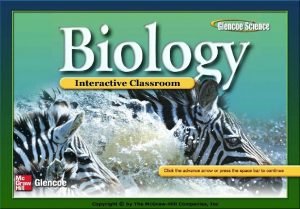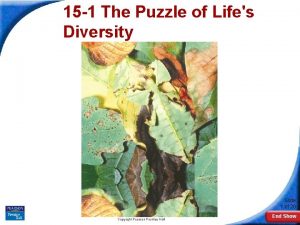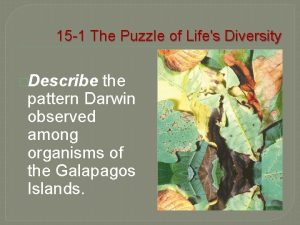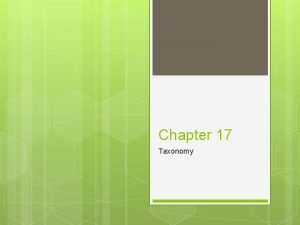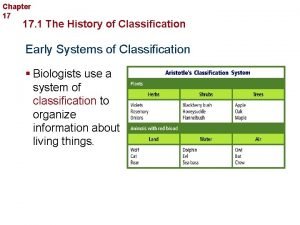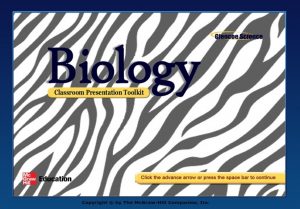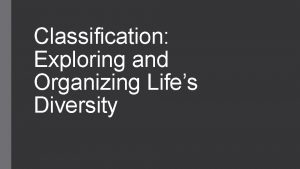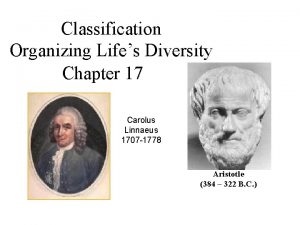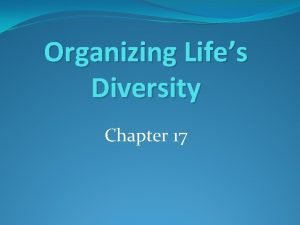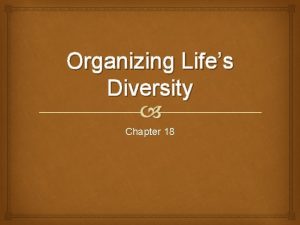Ch 17 Organizing Lifes Diversity 17 1 History








- Slides: 8

Ch. 17 – Organizing Life’s Diversity 17. 1 – History of Classification Taxonomy – branch of biology concerned with identifying, naming, and classifying species Based on a system developed by Carolus Linnaeus in 1748 Linnaeus’ system involved classifying organisms in a series of groups from large and general to smaller and more specific according to physical characteristics He also developed a two-part naming system for every species

Ch. 17 – Organizing Life’s Diversity 17. 1 – History of Classification Human Classification Eukaryotic, heterotrophic, multicellular Animalia Vertebrates Chordata Milk-producing, fur/hair covered Mamalia Short snouts, stereoscopic vision, nails not claws, 4 types of teeth Primata Bipedal, large frontal lobes of brain Hominidae Larger brain (>1000 cc), upright forehead, shorter arms, longer legs, language, culture High forehead, small teeth and jaw, defined chin, and ability to create and appreciate art/symbols Homo Sapiens Used as the scientific names for all species (Binomial Nomenclature)

Ch. 17 – Organizing Life’s Diversity 17. 2 – Modern Classification Species are classified today according to physical and genetic characteristics Phylogenetic tree shows evolutionary relationships based on similarities and differences in physical and/or genetic characteristics. There is presumed to be a common ancestor at each node and the distance between nodes indicates the passage of time

Ch. 17 – Organizing Life’s Diversity 17. 2 – Modern Classification Cladogram - shows one branch of a phylogenetic tree and focuses mainly on homologous structures of the organisms Derived trait – A trait not present in the last common ancestor being considered Ancestral trait – Traits retained from common ancestors

17. 3 – Domains and Kingdoms Ch. 17 – Organizing Life’s Diversity The 3 Domains and 6 Kingdoms Eukarya Plantae Fungi Animalia Protista Archaea Bacteria Eubacteria Archaebacteria

17. 3 – Domains and Kingdoms Ch. 17 – Organizing Life’s Diversity Archaebacteria Eubacteria Protista Prokaryotic Unicellular Hetero- or Autotrophic Eukaryotic Uni- or Multicellular Hetero- or Autotrophic -Live in extreme environments -Most bacteria found on Earth -Usually found in aquatic environments Fungi Plantae Animalia Eukaryotic Uni- or Multicellular Heterotrophic (Decomposers) -Absorb nutrients from other organic material Eukaryotic Multicellular Autotrophic Eukaryotic Multicellular Heterotrophic -Have tissues organized into organs and organ systems -Most are mobile -Have cells organized into tissues -Most are immobile

17. 3 – Domains and Kingdoms Ch. 17 – Organizing Life’s Diversity What about Viruses? Viruses containing RNA are called retroviruses -Viruses are non-living. -They are DNA or RNA surrounded by a protein coat (capsid) and are sometimes enclosed within a membrane -A virus needs a host to reproduce -Outside of a host a virus is metabolically inert HIV (a retrovirus) -The virus inserts its genetic material into the host, taking over the host’s functions. -An infected cell creates more viral protein and genetic material.

Ch. 17 – Organizing Life’s Diversity 17. 3 – Domains and Kingdoms What about Viruses? Viral Diseases -A virus may remain dormant for a period of time causing no changes in the host cell, called the lysogenic phase -Common Cold -Influenza -Chicken Pox -Herpes (I & II) -AIDS -But when stimulated, it enters the lytic phase: new viruses are formed, selfassemble, and burst out of the host cell, killing the cell and going on to infect other cells
